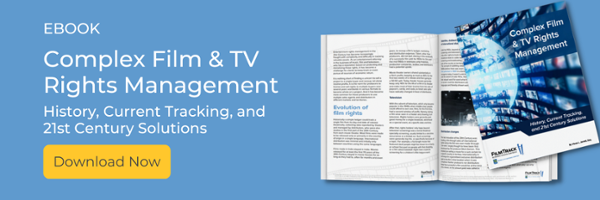The Industry Is Evolving
Historically, a basic ledger could handle a film’s revenue calculations by collecting data reported by theaters and managed by distributors. But things were simpler then. Most films were made to be released only in theaters, primarily in the country of origin, and in a single language.
International distribution was minimal and initially only between countries speaking the same languages. However, modern entertainment rights management has become increasingly complex. It has become a challenge for media companies to track or even pursue all sources of economic return on their assets.
Until the 1970s, movies played in theaters for months to recoup a film’s budget, marketing, and distribution expenses. Movie theater owners shared substantially in a film's profits, keeping up to 80% for the first two weeks of a release before going to a 50-50 split with distributors. Today, ticket sale splits have radically changed in favor of distributors. Movie houses generally keep only 40% for the time a film shows in its theater and must make most of their income from selling popcorn, candy, and soda.
Rights structures have experienced a radical change in recent decades. As a result, contracts have become more and more complex due to several trends, including:
1. Digital Distribution Models
During the 1970s, film producer Mark Damon developed the industry-standard “pre-sales” model, where films receive funding through international sales rights before they are even made.
Many movies since are pre-sold for a certain sum to a specific country or territory in exchange for a guaranteed exclusive distribution right to that film in that location. Since neither producers nor distributors knew how successful a film would be at the time of its release, the amount paid was called a “minimum guarantee” based on how well the film performed.
As a result, sales had to be tracked twice:
- Before production – to collect the advance against sales, usually underwritten by a bank or other lender that paid out 50% upfront and 50% upon delivery of the film
- After release – to ensure that a well-performing film continued to pay out any agreed-to overages
Other factors, such as talent, genre, and theatrical success would trigger additional payments based on a predetermined formula for the box office returns.
2. Performance-Based Models
Theaters have traditionally been the primary setting in which people have viewed films, and for decades, Hollywood studios operated to maximize box office performance. As a result, ticket sales in theaters governed their choice of release dates, how films were promoted, and even the terms in the contracts they sign with producers, television stations, and streaming services.
However, people now increasingly watch film entertainment on their televisions and mobile digital devices. As a result, economic trends in film rights are now moving from traditional waterfalls with a minimum guarantee to more performance-based models with the number of downloads per region, language, etc., with distinctive payouts and varying timelines per segment.
Modern streaming services have adopted a subscription model, leading them to accumulate large film libraries. They have also begun to develop their own proprietary content to attract more users to their platforms and release some of their own films to theaters. Movie theaters, in response, have been adapting their offerings to differentiate from those provided by streaming to digital devices.
3. Bundled Deals
Film creation traditionally requires the “bundling” of writers, actors, and directors to develop a product that can be produced and distributed. Now that traditional media giants are all investing big in streaming platforms, there’s an obsessive focus on bundling services and how consumers will navigate so many direct-to-consumer options. As a result, bundled deals are becoming more and more prevalent, allowing for the packaging of multiple titles.
The Complexity of Bundled Deals
Bundled deals involving SVOD (subscription video on demand)—where a large part of viewing takes place now—bring a whole new level of complexity. As FilmTrack's Sr. Vice President of Product points out:
"When it comes to SVOD...businesses are dealing with hundreds upon hundreds of titles at once, not to mention a faster time to market. As a result, contracts have to be serviced in a swift and timely manner."
For example, suppose a movie is licensed to a SVOD service as part of a bundle with other media. The revenue percentage must be calculated based on the licensing fee divided by the number of other titles in the bundle. And the different currencies collected globally and how they convert into the "home" currency must also be considered.
Media companies must make these calculations efficiently and accurately to ensure that everyone is getting paid what they are owed for the millions of pieces of intellectual property currently in circulation while pursuing new sources of revenue and controlling their risks.
Navigating the Future of Rights Management: Discover the 21st Century Solutions
The landscape of film and TV rights management has transformed dramatically, moving from simple, localized distribution to a complex global network involving multiple platforms and currencies. Traditional tools like spreadsheets are no longer sufficient in this intricate new world, where the risks of mismanagement can lead to significant losses and missed opportunities for entertainment companies.
Our essential ebook, Complex Film & TV Rights Management: History, Current Tracking, and 21st Century Solutions, offers a comprehensive guide to understanding and navigating these challenges. It delves into the evolution of distribution, the impact of ancillary rights, and the complexities of OTT distribution and regional rights. Download now to explore strategic solutions for the 21st century and turn potential challenges into opportunities for success in the dynamic world of entertainment rights management.



